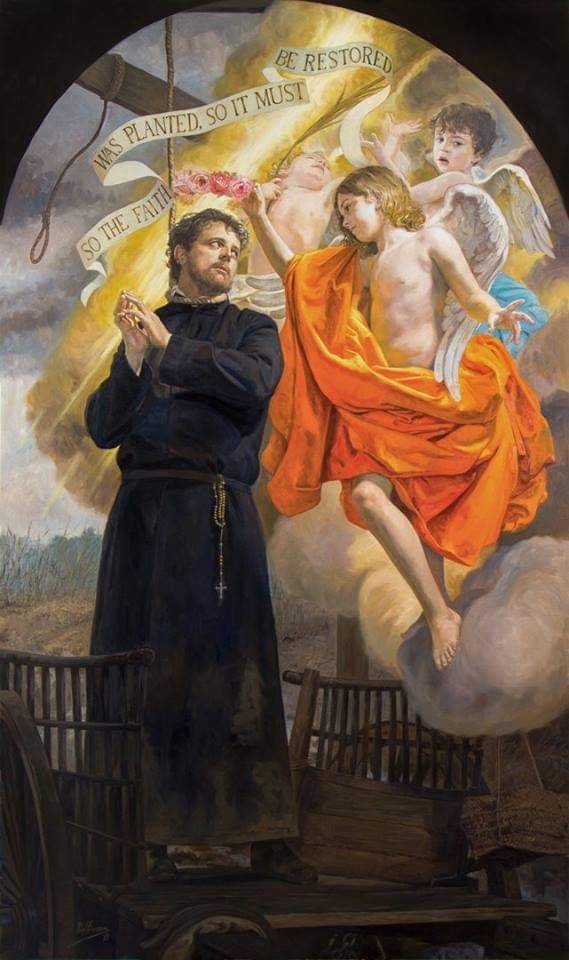#edmund the martyr
Explore tagged Tumblr posts
Text

St Edmund slain by the Danes, AD 870 by Harry Payne
#harry payne#art#st edmund#danes#king#east anglia#vikings#viking#anglo saxon#anglo saxons#martyrdom#martyr#martyrs#saints#edmund the martyr#english#england#medieval#middle ages#christian#christianity#great heathen army#saint#history#europe#european#viking age#invasion#christendom#tree
83 notes
·
View notes
Text
20th November
St Edmund’s Day
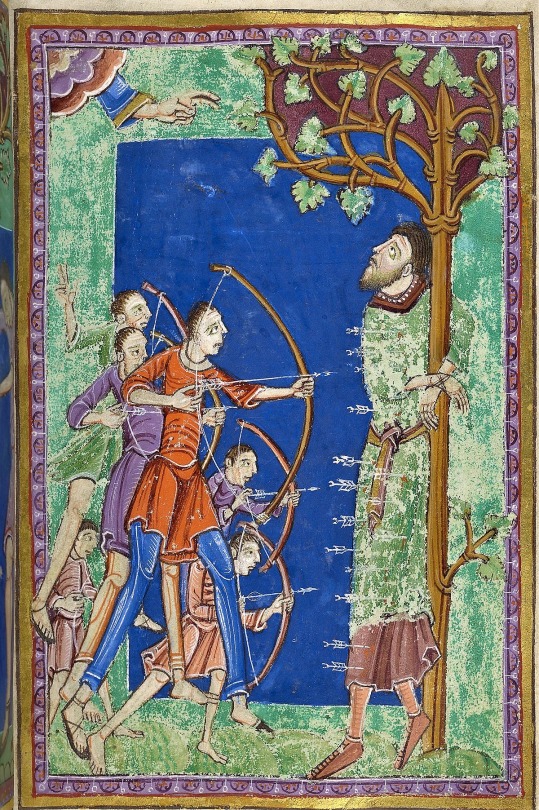
The Martyrdom of Edmund from the Passio Sancto Eadmundi. Source: Wikipedia
Today is St Edmund’s Day. Also known as Edmund the Martyr, he was king of East Anglia when the Anglo-Saxon kingdom was attacked by the Viking Great Heathen Army in 869. Edmund led his soldiers out to oppose the invaders but the East Anglians were defeated. Whether Edmund was killed in the battle of Hoxne in Suffolk or taken prisoner by the Danes and murdered thereafter is a matter of dispute. Tradition has it that the Vikings offered to spare Edmund his life and return him to the throne of East Anglia if he would embrace the Norse pagan religion and rule as a Scandinavian puppet. Edmund supposedly piously refused and paid a grisly price: the Viking warriors tied the king to a tree and shot him full of arrows. Sainthood and martyrdom were then mere formalities. Other traditions make Edmund less heroic. It is said that he fled the field of Hoxne and hid under Goldbrook Bridge, but that the glint of his royal golden spurs was spotted by a newly wed couple who immediately gave him away. As the king was hustled away by the Danes, Edmund cursed all married couples crossing the bridge and to this day, newlyweds in Hoxne take an alternative route home.
Edmund was buried in a Suffolk town which appropriately became named Bury St Edmunds thereafter. His feast day remained popular in the county with a special bun being baked and issued to schoolchildren every November 20th. Unsurprisingly it was called St Edmund’s Bun.
#st Edmund#battle of hoxne#suffolk#great heathen army#viking invasions#east Anglia#Edmund the martyr#goldbrook bridge#st Edmund’s bun#bury st edmunds
2 notes
·
View notes
Text
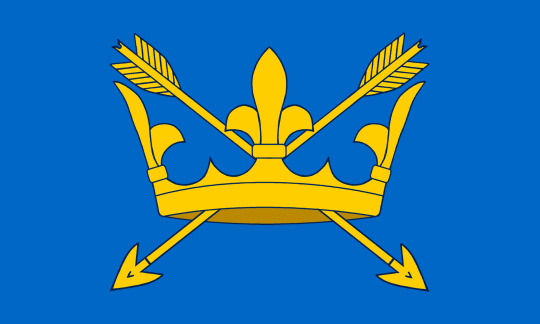
Flag of Saint Edmund the Martyr, original Saxon saint of England.
0 notes
Text

Happy Feast Day
Saint Edmund Campion
1540-1581
Feast day: December 1
Saint Edmund Campion was an English Roman Catholic Jesuit priest and martyr. While conducting an underground ministry in officially Anglican England, Campion was arrested by priest hunters. Convicted of high treason, he was hanged, drawn and quartered at Tyburn. He is one of the Forty Martyrs of England and Wales.
Prints, plaques & holy cards available for purchase here. (website)
#Saint Edmund Campion#English saint martyrs#catholic art#artist on tumblr#catholic faith#portraitsofsaints
42 notes
·
View notes
Text
I know we all love our St Sebastianification of Celebrimbor, for obvious gay reasons, but I'm going to throw this out as something more closely connected to Tolkien's own field of obsession:
St Edmund the Martyr

fwiw, I don't think we really have to go looking for historical/mythological parallels in every single thing Tolkien put down in his books (man had an imagination of his own), but he was your certified nut for all things Old English, so it's quite fun when you notice something that seems to resonate. :)
Edmund (d. AD 869) was King of East Anglia. Unlike St Sebastian, who was martyred during an imperial purge of Christians, Edmund died at the hands of an invading army. This was the time of the Great Heathen Army, a great Viking coalition that made war in Britain from 865, and in some versions Edmund died at the hands of the (in?)famous Viking king Ivar the Boneless. First Ivar sent him a message, demanding his submission, as well as all his treasure and heirlooms. (A bit like Sauron attacking Eregion in pursuit of the Three Rings and having his army ransack the House of the Mírdain in search of the Three Rings?)
Needless to say, Edmund refused these terms and Ivar attacked. Rather than flee, the King resolved to stand firm and face the attackers, not unlike Celebrimbor meeting the Mordor hordes alone at the door of his house. According to the most well-known version of his death, first he was tortured with whips and rods, but when that failed to break his spirit, they shot him through with arrows (or spears) "as if it was a game, until he was entirely covered with their missiles, like the bristles of a hedgehog."
The Vikings didn't use Edmund's body as a war-banner, but they did desecrate it by cutting off the head and hiding it in a bramble thicket, so he could not be buried properly. But, so the story goes, a friendly wolf guarded the head from being gobbled up by any other woodland scavengers, until it could be recovered by his people and buried along with the body. (Which has absolutely nothing to do with Celebrimbor; it's just a good story. Old saints' lives are the best.) Many miracles soon became attributed to the murdered king, and his shrine was moved from its original burial place to the town which is now called Bury St Edmund's. He was venerated as one of England's patron saints until St George was given the role in the later Middle Ages.

11 notes
·
View notes
Text
for @dcynnight continued from here

Josephine didn't think that Teddy was clueless at all. In fact she was aware that he was quite intelligent. She never went into something without first having done her research, she was a professional after all. However he was really the only chance that she had at receiving any type of insider information. She was fully aware that they were feeding her bullshit... that was usually always the first step when the person that she sat down with knew the line of work that she was in. "Are the two of you close?" she questioned, steering it away from a business intensive conversation into one a little more casual, hoping to maybe lower his guard just a smidge.
#◟misery loves company | ↳ josephine moore / interactions◝#◟i am not a martyr i'm a problem | ↳ josephine moore ft. edmund dizon 001◝#◟i keep on looking at the world like i'm an optimist | ↳ josephine moore & edmund dizon◝#◟you bled your soul into things you can't control | ↳ josephine moore / mundane verse◝#◟willow speaks | ↳ ooc / it was perfect thank's so much for the reply◝
8 notes
·
View notes
Text

Saint Edmund the Martyr by Karl Fitzgerald
14 notes
·
View notes
Text
SAINT OF THE DAY (December 1)

Edmund Campion was born in London on 25 January 1540. He was raised as a Catholic.
He had such a powerful and flamboyant intellect that at the age of only 17, he was made a junior fellow at Saint John’s College of Oxford University.
On visiting the university, Queen Elizabeth I was so taken by Edmund’s brilliance, as were a few of her dignitaries, that she bid him to ask for anything that he wished.
The exaltation and praise of so many fed his vanity and eventually led him away from his Catholic faith.
He took the Oath of Supremacy and acknowledged the Queen as head of the church. He also became an Anglican deacon.
However, his brilliant intellect and his conscience would not allow him to be reconciled to the idea of Anglicanism for too long.
After staying a period of time in Dublin, he turned back to his Catholic faith and returned to England.
At this point, he was suspected of being too Catholic and was shaken when he witnessed the trial of a soon to be martyr.
It carried him to the conviction that his vocation was to minister to the Catholic faithful in England who were being persecuted. He also felt the call to convert Protestants.
He set off to Rome barefoot. In 1573, he entered the Society of Jesus.
He was ordained in 1578 and had a vision in which the Virgin Mary foretold him of his martyrdom.
When he returned to England, he made an immediate impression, winning many converts.
On 17 July 1581, he was betrayed by one of the faithful who knew his whereabouts and was thrown into prison.
The queen offered him all manner of riches if he would forsake his loyalty to the Pope, but he refused.
After spending some time in the Tower of London, he was sentenced to death by hanging, drawing, and quartering.
His martyrom in Tyburn on 1 December 1581 sparked off a wave of conversions to Catholicism.
He was beatified by Pope Leo XIII on 29 December 1886. He was canonized by Pope Paul VI on 25 October 1970, as one of the Forty Martyrs of England and Wales.
3 notes
·
View notes
Text

0 notes
Video
youtube
Martyrs Memorial ~ Bury St Edmunds #burystedmunds #martyrsmemorial #cat...
#youtube#martyrsmemorial#martyrs#memorial#bury st edmunds#cathedral#history#tudor#religious persecution#grade2#listed building#suffolk
0 notes
Text
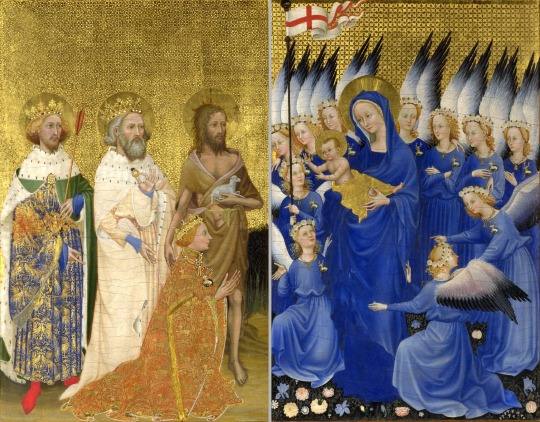
The Wilton Diptych (1395–1399)
The kneeling King Richard II is presented by Saints John the Baptist, Edward the Confessor and Edmund the Martyr, each holding their attribute. In the right-hand panel the Virgin Mary with the Christ Child in her arms is surrounded by eleven angels, against a golden background and field of delicately coloured flowers.
#middle ages#medieval#mediaeval#england#altarpiece#richard ii of england#english#king#saints#kings#saint#john the baptist#edward the confessor#edmund the martyr#virgin mary#christ child#angels#art#christianity#christian#religious art#religion#history#gothic#heraldry#house of wessex#anglo saxon#anglo saxons#flowers#richard ii
84 notes
·
View notes
Text
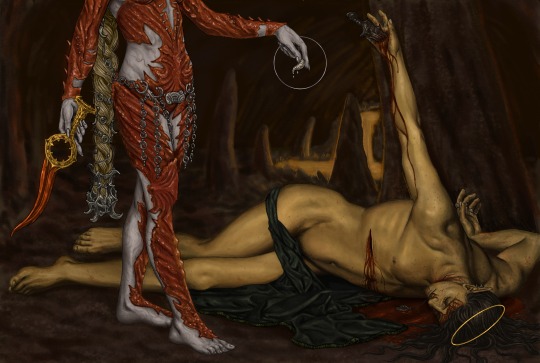
The Martyr

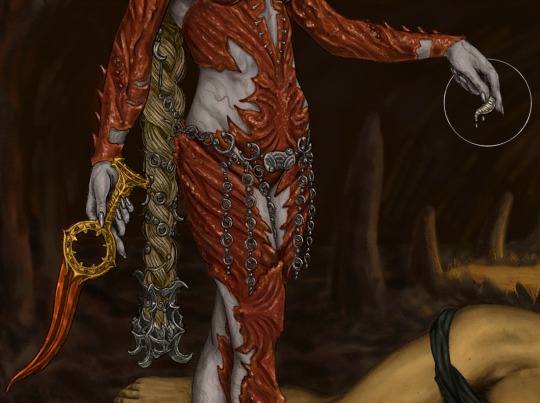
(Saint Edmund the Martyr King of England, Luc-Olivier Merson)
#this made me a little bit crazy but I hope you like it#symbolism save me#save me symbolism#bg3#bg3 fanart#durgetash#implied#bg3 spoilers#the dark urge spoilers#baldur's gate 3#durge#the dark urge#orin the red#virgil acheron#my art#tw blood#brutus brutus brutus brutus
1K notes
·
View notes
Photo

Battle of Edington
The Battle of Edington, fought in May 878 in southwest England, saw Alfred the Great, King of Wessex (r. 871-899), win a decisive victory over the Viking leader Guthrum (d. 890). Two weeks later, under the terms of the Treaty of Wedmore, Guthrum surrendered, agreeing to both convert to Christianity and leave Wessex.
In the months leading up to the battle, the Vikings had overrun much of England, and with Guthrum's invasion of Wessex in January 878, the last Anglo-Saxon kingdom stood on the brink of collapse. After being forced into hiding in the Somerset marshes, Alfred eventually regathered his army and defeated the invaders. His triumph compelled Guthrum to retreat to East Anglia, where he ruled as king.
In the years that followed, the two kings worked to establish a more peaceful coexistence between the Norse settlers and the Anglo-Saxons. However, Alfred's successors eventually embarked upon the reconquest of the lost Anglo-Saxon kingdoms, and Edington would, in time, be marked as the first of many great victories in their quest to unify England under a single ruler.
The Vikings' Arrival
The Viking raids in Britain started in 788, when three ships of Norse pirates landed at Portland, Dorset, where they killed a local reeve (royal official). However, the raid that truly horrified the Anglo-Saxons came five years later when a group of Vikings attacked the monastery of Lindisfarne near the Anglo-Scottish border, which housed the relics of Saint Cuthbert, one of England's most revered saints. The famous scholar Alcuin (d. 804) lamented, "Behold, the church of St Cuthbert spattered with the blood of the priests of God, despoiled of all its ornaments; a place more venerable than all in Britain is given as a prey to pagan peoples" (Whitelock, 899).
Emboldened by their early success, by the mid-9th century, the Vikings were targeting the wealthy towns of Canterbury and London and defeating kings in battle. Alfred was born into this turbulent and unstable world in 849. England as we know it today did not yet exist and was divided into four kingdoms: East Anglia, Mercia (the Midlands), Northumbria (northern England), and the southern kingdom of Wessex, which was ruled by Alfred's father, King Aethelwulf (r. 839-858).
By 865, the Viking threat escalated as Ivar the Boneless, the Viking ruler of Dublin (r. 857-873), assembled a coalition of fleets – known to contemporaries as the 'Great Army' – from Norse bases in Francia, Frisia, Scandinavia, and the Hebrides. Backed by perhaps as many as 5,000 warriors, Ivar and his allies achieved swift success, conquering York, the capital of Northumbria, in 866. Three years later, in 869, they turned south to East Anglia, defeating its ruler, King Edmund (r. 855-869). After refusing to surrender to pagans, Edmund was rewarded with a martyr's death – tied to a tree, he was fired at with spears and beheaded.
Read More
⇒ Battle of Edington
61 notes
·
View notes
Text

Saint Edmund Arrowsmith
1585-1628
Feast Day: August 28
Saint Edmund Arrowsmith, born Brian Arrowsmith, but preferred his confirmation name Edmund was a Jesuit martyr. His family suffered steadfastly for their Catholic faith through the anti-Catholic period in England. His parents were arrested when Edmund was a child. He never saw them again. In 1605, he left England and became a priest in Douai, Belgium, and returned in 1612 to serve for 15 years in Lancashire. In 1622, he was arrested for being a priest, only to be pardoned by King James I. He became a Jesuit after he completed the Ignatian Spiritual Exercises in 1624. Once again he was betrayed as a priest in 1628 and hanged and quartered. His last words were, “Bone Jesu” (O good Jesus). He’s one of the 40 Martyrs of England and Wales.
Prints, plaques & holy cards available for purchase here: (website)
35 notes
·
View notes
Note
completely unrelated to the topic of this blog (dead gay wizards) but i wanted to know if you have book recs (not necessarily fiction) about catholicism and/or the middle ages. i know it’s VERY random but it’s always something that interested me even though i never really researched about it and i see you talk about saints (literally the name of tour blog) so i guess you are knowledgeable about that topic!! anyways thanks <3
okay i’m lightly stoned in my bedroom so i’m given to sentimentality but i smiled reading this… yes i CAN give you recs on those things
books
the myth and cult of the virgin mary, marina warner - longtime favorite. 100/10 could not recommend more.
woman defamed and woman defended: an anthology of medieval texts, alcuin blamires - really good collection of primary sources
lieutenant nun: memoir of a basque transvestite in the new world - autobiography of a runaway nun who lived as a man & swashbuckled <3
giovanni and lusanna: love and marriage in renaissance florence, gene brucker - combined scholarship and narrative. really beautiful
the nonexistent knight, italo calvino & the name of the rose, umberto eco are my fave literary fiction set at the time <33
articles / scholarship
“Negotiating for Agnes’ Womb”, Bastress-Dukehart
“Did Women Have a Renaissance?”, Kelly-Gadol
“Heretics, Martyrs, and Witches”, Alec Ryrie
primary sources / medieval lit
if anything at all read hildegard of bingen, julien of norwich, and margery kemp. <3 all timers
the heptameron, marguerite de navarre
sir orfeo, anonymous (trans. jrr tolkien)
the faerie queene, edmund spenser
the facetious nights of straparola, giovanni straparola
the ultimate ambition in the arts of erudition, shihab al-din al-nuwayri <- so so good
most of these are taken from the syllabus for a class i took called “perceptions of medieval and early modern women”. but i tried to include deep cuts and major favorites. I LOVE YOU MIDDLE AGES <3
69 notes
·
View notes
